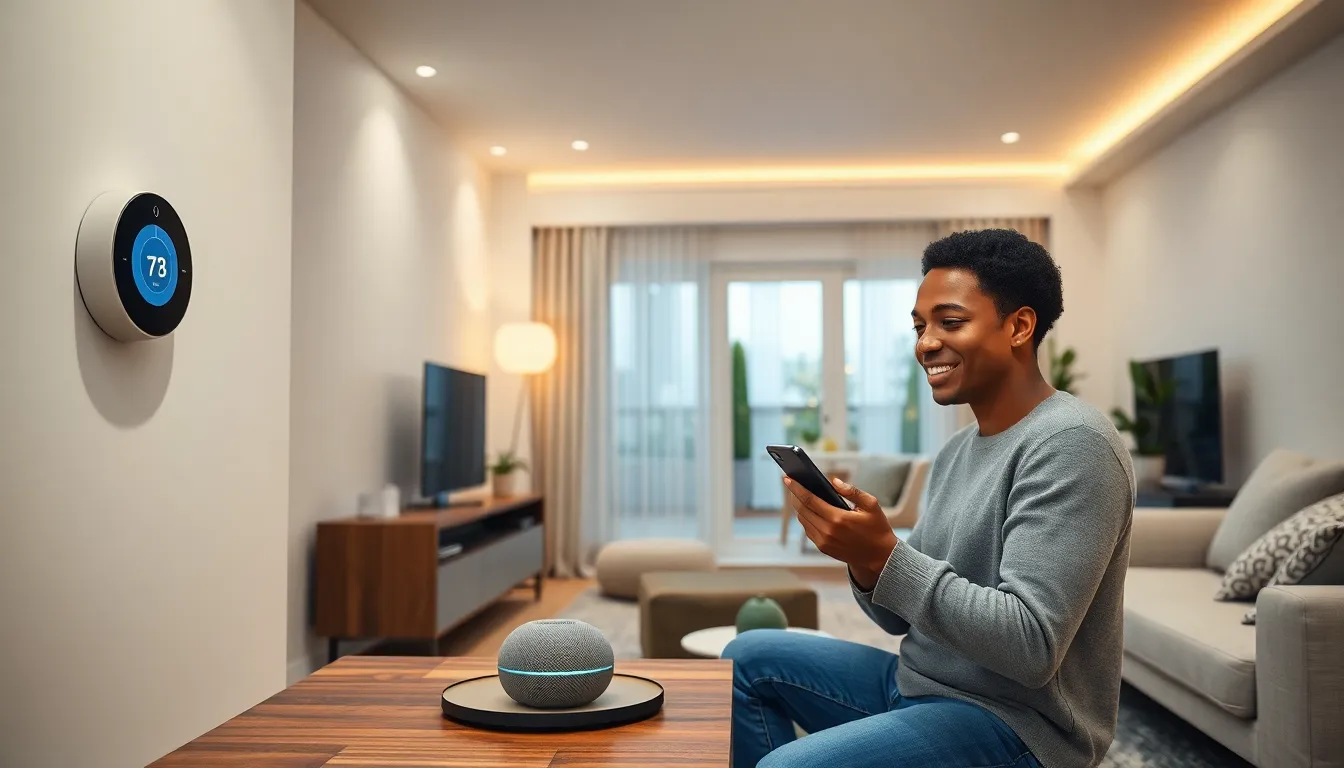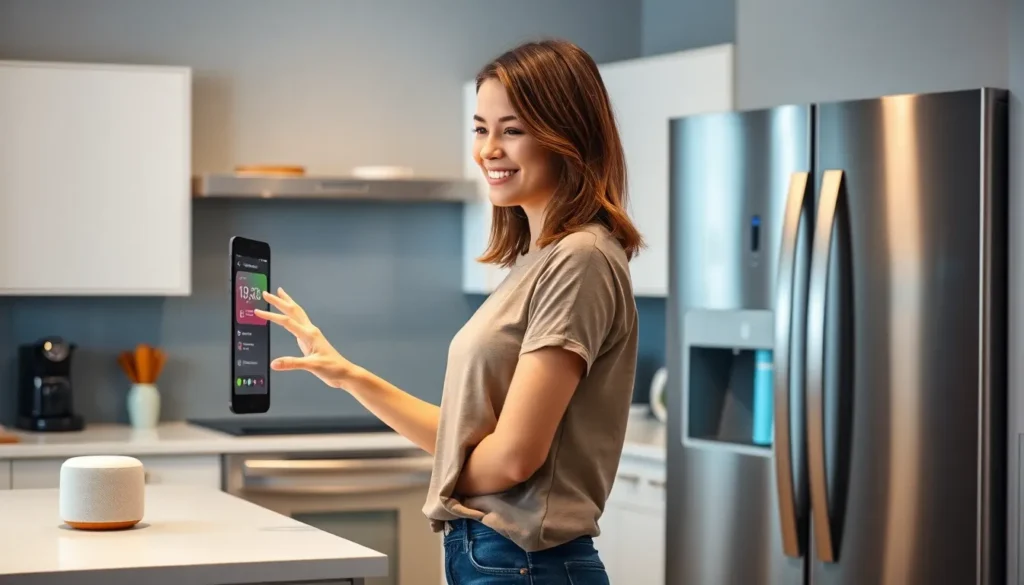In a world where even your toaster can be smarter than your average bear, smart living has become the buzzword of the decade. Imagine a life where your home anticipates your needs, your coffee brews itself, and your fridge gently reminds you that those leftovers have been hanging around a bit too long. It’s not just a fantasy; it’s the reality of smart living, where technology meets convenience in the most delightful ways.
Table of Contents
ToggleOverview of Smart Living
Smart living integrates advanced technology into daily life, enhancing convenience and efficiency. Innovations in smart home design allow systems to optimize energy use while providing comfort. Intelligent devices automate tasks, such as adjusting lighting based on occupancy or climate control to fit personal preferences.
Connected appliances enable communication with users, offering real-time updates on maintenance needs or operational status. For example, smart refrigerators can track inventory, notifying users of expiration dates and suggesting recipes based on available ingredients.
Home security systems feature smart locks and cameras, enhancing safety through remote monitoring and notifications. Automated lighting enhances security by simulating occupancy when residents are away.
Smart living extends beyond the home; wearable technology tracks health metrics and provides insights into fitness. This data empowers users to make informed decisions about their well-being. Smart cities exemplify the concept with integrated transport systems, improving traffic management and resource allocation.
Environmental sustainability gains importance in smart living. Energy-efficient devices and renewable energy sources minimize carbon footprints while maintaining comfort and functionality. Smart irrigation systems optimize water usage in agriculture, adapting to weather conditions and soil moisture levels.
Overall, smart living represents a significant shift in how individuals interact with their environment. Lifestyle enhancements result from seamless integrations of technology, making everyday tasks simpler and more enjoyable.
Benefits of Smart Living

Smart living significantly enhances daily experiences through its numerous advantages. Smart technology seamlessly integrates into homes and lifestyles, promoting comfort and security.
Improved Convenience
Convenience reaches new heights with smart living solutions. Smart devices automate household tasks. Smart thermostats adjust temperatures based on personal schedules, reducing energy waste. Automated lighting systems create the perfect ambiance without manual intervention. Voice-activated assistants manage daily routines, from setting reminders to ordering groceries. Homeowners save time and increase efficiency by simply using their smartphones or voice commands. Furthermore, connected appliances track inventory and suggest recipes based on available ingredients. This level of automation ensures everyday tasks become less burdensome, allowing individuals to focus on what truly matters.
Enhanced Security
Enhanced security stands out as a crucial benefit of smart living. Smart locks provide keyless entry, allowing users to manage access to their homes remotely. Surveillance cameras equipped with real-time notifications alert homeowners to any unusual activity. Additionally, smart lighting systems simulate occupancy patterns, increasing the safety of homes when residents are away. Smart security systems often integrate with mobile devices, enabling users to monitor and control their properties from anywhere. This interconnectedness not only offers peace of mind but also deters potential intruders. As technology advances, those investing in smart living will likely enjoy heightened security and assurance.
Key Technologies in Smart Living
Smart living relies on various technologies that enhance comfort, security, and efficiency in everyday life. Integral to this evolution are smart home devices and IoT integration.
Smart Home Devices
Smart home devices form the backbone of intelligent living environments. Thermostats learn user preferences, automatically adjusting temperature settings for energy savings. Smart lighting adapts to various activities, providing the right ambiance while conserving electricity. Voice-activated assistants manage daily schedules and control connected devices, improving convenience. Appliances like refrigerators track food inventories, sending alerts when supplies run low. Security systems monitor homes via cameras and smart locks, enabling remote access and notifications. Together, these devices create a seamless experience that simplifies tasks and increases safety.
IoT Integration
IoT integration connects numerous devices, allowing them to communicate and work together efficiently. Sensors placed throughout homes collect data on usage patterns, optimizing energy consumption. Devices send alerts to users regarding maintenance requires, reducing the risk of system failures. Smart irrigation systems utilize weather data to manage water usage effectively, enhancing agricultural efficiency. Cities employ IoT technology to monitor traffic patterns, improving transportation management. This interconnectedness enhances user experiences and drives innovative solutions for sustainable living.
Challenges of Smart Living
Smart living introduces several challenges that affect users’ experiences and expectations.
Privacy Concerns
Users often express worries about data privacy. Smart devices frequently collect personal information, raising risks of unauthorized access or data breaches. This reliance on cloud services for storage exacerbates these issues. Many smart home systems lack robust security features, creating vulnerabilities. Instances of hacking, such as unauthorized control of connected cameras and locks, highlight these risks. Striking a balance between convenience and privacy has emerged as a significant concern in smart living environments. Advocates recommend using devices with strong encryption and updated software to mitigate these challenges.
Technical Limitations
Technical limitations can hinder the effectiveness of smart living. Connectivity issues, particularly with Wi-Fi networks, create disruptions in device communication. Furthermore, not every user possesses the technical skills needed to troubleshoot problems with smart devices. Compatibility among various brands and systems sometimes poses a challenge, resulting in fragmented smart home experiences. The cost of advanced technology can also limit access for some users, leading to a digital divide. Addressing these technical limitations is essential for achieving a seamless smart living experience that benefits all users.
Future Trends in Smart Living
Innovative concepts define the future of smart living. Advances like AI-driven personal assistants will provide customized experiences, anticipating individual needs. Smart appliances equipped with machine learning capabilities will improve efficiency and convenience in daily tasks.
Integration of blockchain technology in smart home systems promises enhanced security and privacy. Users can expect data protection strategies that ensure personal information remains secure. Improved compatibility among devices will lead to seamless operation across different brands, enhancing user experience.
Energy management systems are set to become more sophisticated. Sensors will optimize energy use based on real-time data, contributing to sustainability efforts. Solar panels along with smart grids will provide homeowners with more control over energy consumption.
Wearable health technology is also evolving. Devices monitoring vital signs and providing health analytics will empower users to maintain better wellness. Enhanced connectivity across platforms will allow these devices to sync with home systems for a comprehensive health overview.
Smart cities are an emerging focus, incorporating IoT solutions to improve urban living conditions. Data-driven traffic management systems will alleviate congestion, while smart waste management systems enhance environmental sustainability. As these advancements unfold, urban environments will become increasingly efficient and livable.
In the realm of smart security, improved facial recognition and biometric technologies will heighten protection. Automated alerts and remote monitoring will enable residents to respond to potential threats proactively. Enhanced collaboration among various security systems will create a more integrated approach to safety.
The future of smart living hinges on continuing advancements in technology and innovation. Emphasis on user-friendly experiences and environmental sustainability will shape this dynamic landscape, fostering a lifestyle that promotes convenience, safety, and well-being.
Smart living is reshaping how individuals interact with their surroundings by seamlessly integrating technology into everyday life. This evolution not only enhances convenience and security but also promotes sustainability and efficiency. As intelligent devices become increasingly prevalent, they empower users to focus on what truly matters while optimizing their home environments.
The future of smart living holds exciting possibilities with advancements in AI and IoT. These innovations will continue to refine user experiences and address challenges such as privacy and connectivity. Embracing smart living can lead to a more fulfilling lifestyle where technology works harmoniously to improve daily routines and overall well-being.



